The Point of View concept is better developed on my Film-Pomo Guide-Page (Deep Theory, not required for this class).

Film is an extreme art: patatheatre -- the teatricality of our rutine existance in postmodern conditions. no static pictures and music/sound in constant dynamic relations with the visuals! Read Debord "Society of Spectacle" (1969), I follow his idea.
The paintings by Klimt (1907)

Film&Drama (archive page)
DIRECTORIES, PAGES
Rules of the languageFront Page and DIRECTING
200X Art:
If you go through the images from ART.COM (From Leonardo to Dali), one trend becomes obvious -- art moved into a zone of the subjective. Styles of this process have many names -- impressionism, expressionism, dada, abstract... but one thing remains: artist himself not the world is the subject.
If first artists (pre-history) discovered the world (animals mostly), soon we realized that Man is the center of the world, bout only in the late modernity this focus find the only man, the world of an individual. History of Fine Art from portrait as genre sees the transformation of method-subject: I do not paint myself, but the world the way I see it. [...]
Next: Intro
 Eisenstein : Montage.101
Eisenstein : Montage.101
